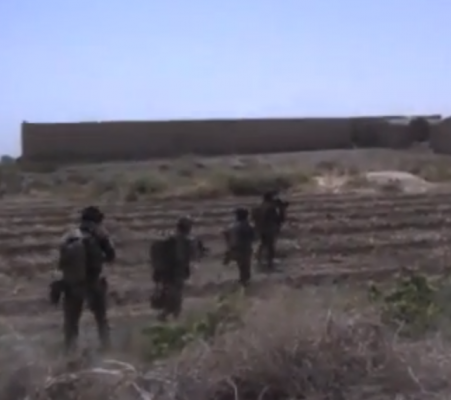The best combat leaders all have one thing in common: they lead from the front. They share the same burdens as their soldiers. They never spare themselves. They never ask a subordinate to carry out a task they are not willing to do themselves and in combat they physically place themselves in the line of fire shoulder to shoulder with the troops under their command.
But why does leading from the front work so well?

A group of soldiers move across open ground. The second soldier is their leader, one of my sub-commanders.
Picture: A snapshot from one of my soldier’s helmet camera during operation Panther’s Claws, Helmand province, Afghanistan, 2009
Who would you follow?
Think about it. Who would you rather follow:
- The leader who stays in the rear and issues orders via the radio.
- The leader who is in the line of fire alongside his troops issuing orders verbally.
We would all follow the leader who chooses to fight alongside us, who is a part of the team. By doing so the leader shows the importance of the task at hand. He also shows that his soldiers’ lives are not of less importance than his own. With the leader participating, the unit fights as a team.
The leader as a part of the team
Leaders are not above their teams. They are a part of it. Leaders depend on their soldiers to provide their part. Leaders provide leadership. The machine gunner provides fire power. Neither is more important than the other: both are needed to get the job done. Participating as a part of the team gives you soldiers who are willing to go an extra mile for you, because they know that you are willing to do the same for them.
Gain a better understanding of the situation
The leader who is out on the ground personally will better understand the situation. Layers are removed and the leader will receive information unfiltered, reducing the risk of misunderstandings and of the right orders issued on the wrong basis.
Reduce combat stress
In combat fear is a basic condition. A well performing team is better able to cope with stress than a group of individuals. A team without their leader in the line of fire will be more likely to fall apart than a team with a leader who is out on the ground and able to remain “cool under fire”. Personally, I have found that the best combat leaders under my command were the ones able to remain cool under fire. By doing so they were able to project their coolness to their soldiers. By leading from the front they offered the soldiers a model to mirror in combat.
This reduces fear and increases the ability to make sound decisions in combat.
Is it dangerous to lead from the front?
During the Yom Kippur war in 1973 the heaviest Israeli casualties were among tank commanders. They were leaders who had to expose themselves to get an overview of the situation in order to make decisions. Combat leaders today also bear a higher risk than the individual soldier.
However, what is the alternative? A unit with lack of leadership, lack of trust and lack team spirit. A unit who might not be capable of reaching its objectives. The leader’s job is to take the responsibility. In spite of danger. The soldiers expect it from you.
By leading from the front you might create a more effective combat unit thus reducing the risk for all the soldiers in the unit including yourself.
Can you lead too much?
Although you choose to lead from the front you should still give subordinates room to carry out their tasks. A leader who personally mans the machine gun because he wants to show the way has failed. Remember, the leader’s responsibility is to create the best possible conditions for others to do their jobs. In combat it is easy to get carried away. Take three deep breaths and focus on why you are there. Lead your troops.
Leaders are defined by actions not words.
Leading from the front is not only a combat trait. It is a classic leadership trait. In your everyday life as a leader you will always be defined by your actions not by your words. Writing long theses on how to be a great leader is a lot easier than doing it.
However, leadership is about taking action. Not talking.
Start taking action. Lead from the front every day.
Hi Soren,
wonderful! I really enjoyed your article.
For me this is what real leadership is about:
Leaders are a part of the team and help the team being successful.
I think when we are in one row with the team we make a better impact in people’s life. People are always more important than we.
I admire the great work you do!
Best regards
Karin
Hi Karin,
Thanks for commenting and sharing. It’s much appreciated.
I agree. I think, however, some leaders tend to forget that they are a part of the team. They place themselves above or besides the team. But that will not make people follow in the long run.
Soren
Karin,
Leading a unit in combat requires the leader become part of the locked arms of the unit that indicates complete trust. Rank alone does not insure leadership under fire. Trust is the earned collateral of the true leader. It is earned from being in front, being consistent, having no favorites, and being the most trustworthy combatant in the unit. Do that and your men will follow you anywhere. I enjoyed your article.
Bob
Thanks for your comment and your kind words Bob.
That trust is earned is an important leadership lesson. And the best place to earn it is to lead from the front.
Soren
Pingback: Følg mig! Hvordan det at lede fra front kan styrke dit lederskab | Søren Sjøgren